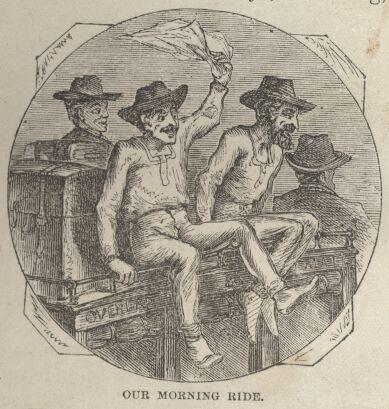Stagecoach from St. Joseph, Missouri to the eastern base of the Rocky Mountains, Fort Laramie.
The first thing we did on that glad evening that landed us at St. Joseph was to hunt up the stage-office, and pay a hundred and fifty dollars apiece for tickets per overland coach to Carson City, Nevada.
The next morning, bright and early, we took a hasty breakfast, and hurried to the starting-place. Then an inconvenience presented itself which we had not properly appreciated before, namely, that one cannot make a heavy traveling trunk stand for twenty-five pounds of baggage—because it weighs a good deal more. But that was all we could take—twenty-five pounds each. So we had to snatch our trunks open, and make a selection in a good deal of a hurry. We put our lawful twenty-five pounds apiece all in one valise, and shipped the trunks back to St. Louis again. It was a sad parting, for now we had no swallow-tail coats and white kid gloves to wear at Pawnee receptions in the Rocky Mountains, and no stovepipe hats nor patent-leather boots, nor anything else necessary to make life calm and peaceful. We were reduced to a warfooting. Each of us put on a rough, heavy suit of clothing, woolen army shirt and “stogy” boots included; and into the valise we crowded a few white shirts, some under-clothing and such things. My brother, the Secretary, took along about four pounds of United States statutes and six pounds of Unabridged Dictionary; for we did not know—poor innocents—that such things could be bought in San Francisco on one day and received in Carson City the next. I was armed to the teeth with a pitiful little Smith & Wesson’s seven-shooter, which carried a ball like a homeopathic pill, and it took the whole seven to make a dose for an adult. But I thought it was grand. It appeared to me to be a dangerous weapon. It only had one fault— you could not hit anything with it. One of our “conductors” practiced awhile on a cow with it, and as long as she stood still and behaved herself she was safe; but as soon as she went to moving about, and he got to shooting at other things, she came to grief. The Secretary had a small-sized Colt’s revolver strapped around him for protection against the Indians, and to guard against accidents he carried it uncapped. Mr. George Bemis was dismally formidable. George Bemis was our fellow-traveler. We had never seen him before. He wore in his belt an old original "Allen” revolver, such as irreverent people called a “ pepper-box.” Simply drawing the trigger back, cocked and fired the pistol. As the trigger came back, the hammer would begin to rise and the barrel to turn over, and presently down would drop the hammer, and away would speed the ball. To aim along the turning barrel and hit the thing aimed at was a feat which was probably never done with an “Allen” in the world. But George’s was a reliable weapon, nevertheless, because, as one of the stage-drivers afterward said, “If she didn’t get what she went after, she would fetch something else.” And so she did. She went after a deuce of spades nailed against a tree, once, and fetched a mule standing about thirty yards to the left of it. Bemis did not want the mule; but the owner came out with a double-barreled shotgun and persuaded him to buy it, anyhow. It was a cheerful weapon—the “Allen.” Sometimes all its six barrels would go off at once, and then there was no safe place in all the region round about, but behind it.
We took two or three blankets for protection against frosty weather in the mountains. _ In the matter of luxuries we were modest—we took none along but some pipes and five pounds of smoking tobacco. We had two large canteens to carry water in, between stations on the Plains, and we also took with us a little shot-bag of’ silver coin for daily expenses in the way of breakfasts and dinners.
Roughing It
See Richard F. Burton's Preparations for the Journey West
